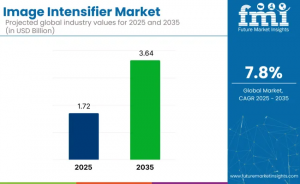Image Intensifier Market Set to Surge to USD 3.64 Billion by 2035 as Global Demand for High-Performance Imaging Soars
Manufacturers Eye Growth in Medical, Military, and Surveillance Applications as Innovation and Regional Expansion Shape Industry Future
NEWARK, DE, UNITED STATES, August 4, 2025 /EINPresswire.com/ -- The global image intensifier market is poised for robust expansion, with market size expected to grow from USD 1.72 billion in 2025 to USD 3.64 billion by 2035, reflecting a CAGR of 7.8%. This steady growth is a result of accelerating demand for advanced low-light imaging solutions across medical diagnostics, defense, industrial inspection, and security surveillance.
Amidst an era of digital transformation and rising safety demands, image intensifiers are stepping into the spotlight—enhancing visibility in the darkest conditions and empowering professionals across sectors with high-resolution, real-time imagery.
Strategic Growth Anchored in Innovation and Utility
As of 2025, non-gated image intensifiers lead the market with a 40% share, due to their affordability and reliability in commercial and industrial applications. Compact, durable, and efficient, these devices are being rapidly adopted for general security, industrial inspection, and automotive surveillance.
Meanwhile, Generation III image intensifiers are projected to dominate the segment with a 45% share, especially within defense and tactical operations, thanks to their unmatched low-light performance, resolution, and durability. Key defense electronics players like Northrop Grumman and L3Harris Technologies are investing heavily in these high-performance solutions to meet the growing need for night vision in surveillance and battlefield reconnaissance.
Medical and Industrial Imaging Fueling Demand
While traditionally associated with defense and security, image intensifiers are now finding increased traction in medical diagnostics and surgical imaging. Hospitals and clinics around the world are incorporating these technologies into diagnostic workflows to enhance accuracy in low-light environments, particularly in radiology and emergency medicine. The devices, while occupying a niche, are critical—holding a 2–3% share in medical imaging and enabling visibility in challenging imaging conditions.
In industrial applications, image intensifiers are also being used for non-destructive testing and quality assurance, particularly in environments where lighting is variable or insufficient. Their ability to amplify low-level light without compromising image integrity gives manufacturers a reliable tool to uphold production standards.
India and China Lead Regional Momentum
The Asia-Pacific region is emerging as the epicenter of market expansion, with India expected to grow at a CAGR of 10.6%, the highest globally. This rapid growth is driven by rising healthcare investments, a surge in medical tourism, and broader access to diagnostic imaging. Companies such as GE Healthcare and Philips are actively expanding their footprints in India to serve this growing demand.
Close behind is China, with a projected CAGR of 9.6%, where technological advancements, expanding urban infrastructure, and state-backed healthcare modernization are propelling adoption. Domestic manufacturers like Shanghai United Imaging Healthcare Co. are playing a pivotal role in delivering cutting-edge solutions tailored for the evolving medical landscape.
Meanwhile, mature markets such as the United States (7.8% CAGR), the United Kingdom (6.2%), and Japan (6.4%) are maintaining consistent growth, bolstered by continuous innovation and modernization of existing imaging infrastructure.
Emerging Applications Reshape the Market Landscape
The 25 mm to 37 mm diameter segment is expected to capture 35% of the industry share, thanks to its suitability for wearable and portable applications. These compact solutions are ideal for handheld tactical devices, consumer gadgets, and field-deployable military gear. Major players like ITT Exelis and Thales are refining these technologies to ensure comfort, durability, and high performance under harsh conditions.
Simultaneously, night vision goggles are projected to secure 20% of the application market by 2025, driven by increased usage in military, law enforcement, and private security. FLIR Systems and Bushnell are at the forefront of innovation here—developing lighter, more ergonomic models that deliver superior performance in complete darkness.
USA Market Expansion Signals Manufacturing Opportunity
“Expansion into the USA market presents a significant opportunity to strengthen our position as a global leader in image intensifier tubes. This new capacity will also enable us to meet customers' demand for large-volume, high-performance products manufactured in the USA,” stated Jérôme Cerisier, CEO of Exosens, highlighting the industry's focus on domestic production and regional fulfillment.
This aligns with the strategic push by top-tier companies like Canon Medical Systems, GE Healthcare, and Philips Healthcare, who are investing in R&D to develop next-gen solutions. The combination of regulatory support and rising healthcare demands in the U.S. is sustaining a stable market with vast potential for innovation.
Key Players Driving Innovation and Market Reach
Leading firms such as L3Harris Technologies, Thales Group, Canon Medical Systems, and PHOTONIS Technologies SAS continue to shape the market with cutting-edge research and broad distribution networks. In December 2023, L3Harris Technologies introduced new-generation intensifier tubes with improved resolution and sensitivity, setting new standards for defense and medical imaging applications.
Further expanding global capabilities, Exosens acquired NightVision Laser Spain (NVLS) in October 2024, boosting its presence in Spain, Latin America, and Asia. These strategic moves reflect the industry’s focus on integration, innovation, and global serviceability.
Challenges and Opportunities Ahead
Despite its growth momentum, the image intensifier market is not without challenges. Intense competition from CMOS and CCD technologies—which often offer longer life spans and less maintenance—continues to pressure manufacturers. Additionally, export restrictions and compliance regulations create operational hurdles and increase costs, particularly for companies looking to expand internationally.
Yet, for manufacturers committed to pushing technological boundaries and aligning with evolving end-user demands, the opportunities remain vast. Whether it’s building devices for high-stakes defense missions or streamlining diagnostics in rural hospitals, image intensifiers are proving indispensable.
Request Image Intensifier Market Draft Report: - https://www.futuremarketinsights.com/reports/sample/rep-gb-22364
For more on their methodology and market coverage, visit https://www.futuremarketinsights.com/about-us
Final Outlook: Future-Proofing Through Innovation and Localization
As the image intensifier industry marches toward 2035, the focus remains clear: improve performance, localize manufacturing, and expand into fast-growing regions. With strong contributions from India, China, and the United States, and with leadership from global innovators and rising challengers alike, the market is well-positioned for dynamic growth.
Manufacturers looking to invest in the future of imaging technology must act decisively—leveraging strategic partnerships, enhancing R&D pipelines, and tailoring offerings for defense, medical, and industrial users alike.
Explore more insights in our related industry reports.
Image Guided Systems Market
https://www.futuremarketinsights.com/reports/image-guided-systems-market
Image Sensors Market
https://www.futuremarketinsights.com/reports/image-sensors-market
Image Recognition in Retail Market
https://www.futuremarketinsights.com/reports/image-recognition-in-retail-market
Rahul Singh
Future Market Insights Inc.
+1 347-918-3531
email us here
Legal Disclaimer:
EIN Presswire provides this news content "as is" without warranty of any kind. We do not accept any responsibility or liability for the accuracy, content, images, videos, licenses, completeness, legality, or reliability of the information contained in this article. If you have any complaints or copyright issues related to this article, kindly contact the author above.
Squirrel Pie — A Harrowing and Hopeful Memoir of Survival, Strength, and Self-Redemption
VFAF Endorses Veterans Kelvin King (GA) and Aaron Reitz (TX); Veterans for America First Covers MiamiGate
High-Rise and Big-Box Fire Serivce Experts Embark Upon Texas for Intensive Structural Fireground Training Session
Więcej ważnych informacji
 Jedynka Newserii
Jedynka Newserii

 Jedynka Newserii
Jedynka Newserii

Polityka

Polska może się stać Doliną Krzemową Europy. Potrzeba jednak wsparcia finansowego start-upów i mocniejszej deregulacji
Polskie start-upy skoncentrowane są głównie na rozwoju nowoczesnych technologii informatycznych i cyfrowych. Wyraźny nacisk na oprogramowanie i aplikacje oraz big data i data science wskazuje na silne zainteresowanie narzędziami analitycznymi i rozwiązaniami wspierającymi transformację cyfrową w różnych branżach – wynika z raportu „Rynek start-upów w Polsce. Trendy technologiczne”, który został opracowany w 2024 roku w MRiT. Zdaniem europarlamentarzystów Polska ma szansę się stać Doliną Krzemową, jednak rozwój start-upów blokowany jest m.in. przez ograniczony dostęp do finansowania oraz niekorzystne i nadmierne regulacje.
Transport
Na półmetku wakacji ceny paliw na stacjach nie powinny się wyraźnie zmienić. Znaczące różnice między regionami i stacjami

W sierpniu ceny benzyny, oleju napędowego i autogazu powinny pozostać na poziomach z lipca – uważa ekspertka rynku z firmy Reflex. Wyższe będą zawsze na stacjach premium, tych, które oferują bogatszą ofertę dodatkową, promocje dla uczestników programu lojalnościowego, oraz w regionach, w których tradycyjnie paliwa są droższe ze względu np. na wyższą siłę nabywczą mieszkańców. Różnice mogą sięgać kilkudziesięciu groszy na litrze. Obszary, wokół których te wartości oscylują, zależą z kolei od sytuacji globalnej. Warto patrzeć na sytuację na Bliskim Wschodzie i w Ukrainie.
Polityka
A. Mularczyk (PiS): Nawiązanie poważnego dialogu z Niemcami jest konieczne nie tylko w kontekście reparacji. Powinien być podpisany traktat polsko-niemiecki

– Nie wystarczy jednorazowy gest czy inicjatywa. To musi być podjęcie dialogu, być może też przygotowanie nowej umowy bilateralnej, nowego traktatu polsko-niemieckiego, który regulowałby wszystkie obszary, które wynikały ze skutków II wojny światowej – mówi Arkadiusz Mularczyk, poseł do Parlamentu Europejskiego z PiS-u. Podkreśla, że proces ten nie będzie łatwy, bo wymaga konsekwencji i stanowczości, ale widzi szansę w prezydenturze Karola Nawrockiego, który już zadeklarował kontynuację starań w tym zakresie. Zdaniem europosła wsparciem w polsko-niemieckim dialogu może być administracja Donalda Trumpa.
Partner serwisu
Szkolenia

Akademia Newserii
Akademia Newserii to projekt, w ramach którego najlepsi polscy dziennikarze biznesowi, giełdowi oraz lifestylowi, a także szkoleniowcy z wieloletnim doświadczeniem dzielą się swoją wiedzą nt. pracy z mediami.




![Nestlé w Polsce podsumowuje wpływ na krajową gospodarkę. Firma wygenerowała 0,6 proc. polskiego PKB [DEPESZA]](https://www.newseria.pl/files/1097841585/fabryka-nesquik_1,w_85,r_png,_small.png)




.gif)

 |
| |
| |
|